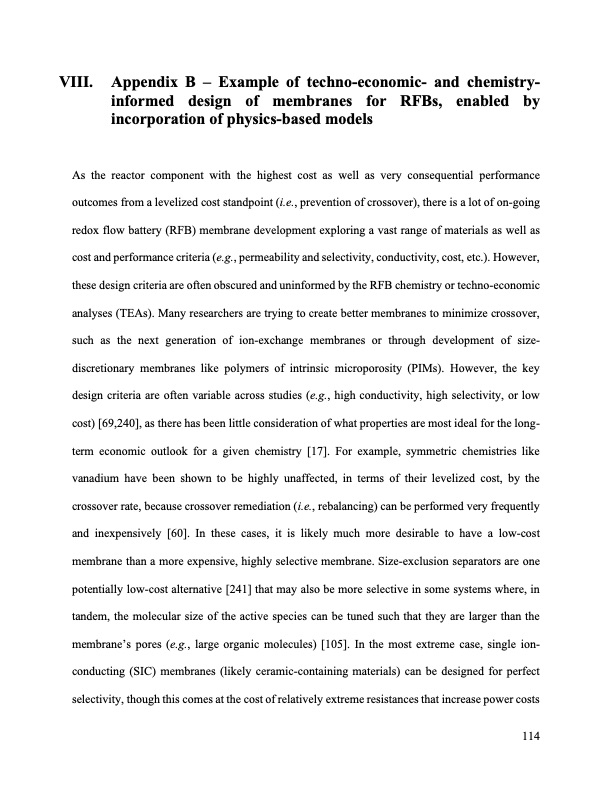
PDF Publication Title:
Text from PDF Page: 114
VIII. Appendix B – Example of techno-economic- and chemistry- informed design of membranes for RFBs, enabled by incorporation of physics-based models As the reactor component with the highest cost as well as very consequential performance outcomes from a levelized cost standpoint (i.e., prevention of crossover), there is a lot of on-going redox flow battery (RFB) membrane development exploring a vast range of materials as well as cost and performance criteria (e.g., permeability and selectivity, conductivity, cost, etc.). However, these design criteria are often obscured and uninformed by the RFB chemistry or techno-economic analyses (TEAs). Many researchers are trying to create better membranes to minimize crossover, such as the next generation of ion-exchange membranes or through development of size- discretionary membranes like polymers of intrinsic microporosity (PIMs). However, the key design criteria are often variable across studies (e.g., high conductivity, high selectivity, or low cost) [69,240], as there has been little consideration of what properties are most ideal for the long- term economic outlook for a given chemistry [17]. For example, symmetric chemistries like vanadium have been shown to be highly unaffected, in terms of their levelized cost, by the crossover rate, because crossover remediation (i.e., rebalancing) can be performed very frequently and inexpensively [60]. In these cases, it is likely much more desirable to have a low-cost membrane than a more expensive, highly selective membrane. Size-exclusion separators are one potentially low-cost alternative [241] that may also be more selective in some systems where, in tandem, the molecular size of the active species can be tuned such that they are larger than the membrane’s pores (e.g., large organic molecules) [105]. In the most extreme case, single ion- conducting (SIC) membranes (likely ceramic-containing materials) can be designed for perfect selectivity, though this comes at the cost of relatively extreme resistances that increase power costs 114PDF Image | Bringing Redox Flow Batteries to the Grid

PDF Search Title:
Bringing Redox Flow Batteries to the GridOriginal File Name Searched:
Rodby-krodby-phd-chemE-2022-thesis.pdfDIY PDF Search: Google It | Yahoo | Bing
Salgenx Redox Flow Battery Technology: Salt water flow battery technology with low cost and great energy density that can be used for power storage and thermal storage. Let us de-risk your production using our license. Our aqueous flow battery is less cost than Tesla Megapack and available faster. Redox flow battery. No membrane needed like with Vanadium, or Bromine. Salgenx flow battery
| CONTACT TEL: 608-238-6001 Email: greg@salgenx.com | RSS | AMP |